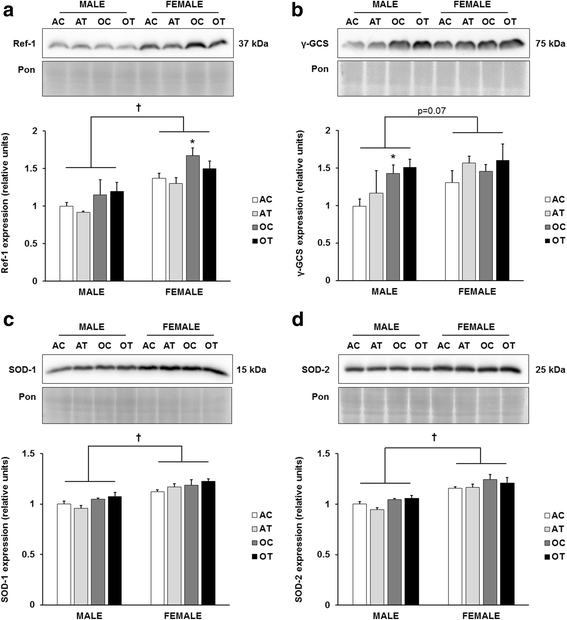Sexual dimorphism in the hepatic protein response to a moderate trans fat diet in senescence-accelerated mice
- PMID: 29237473
- PMCID: PMC5729490
- DOI: 10.1186/s12944-017-0639-7
Sexual dimorphism in the hepatic protein response to a moderate trans fat diet in senescence-accelerated mice
Abstract
Background: Aging is characterized by increases in inflammation and oxidative stress, conditions that are exacerbated by environmental factors such as diet. In this study, we investigated the effects of a trans-fatty acid (TFA) diet on the liver in adult (25 wk) and old (60 wk) senescence-accelerated mice (SAMP8 strain) of both sexes. Our goal was to assess the effects of the diet on protein markers of inflammation and oxidative stress in the liver.
Methods: Male and female mice were placed on life-long diets containing similar amounts of total fat (17%), with differing amounts of TFA: 2% (moderate TFA group) or 0.2% of total energy from TFA (control diet group). At the indicated ages, livers were harvested and evaluated for markers of inflammation and oxidative stress, as well as for enzymes of fat metabolism via immunoblotting. Relative densities of protein bands were determined and compared via a three-factor ANOVA.
Results: Compared to males, females demonstrated significantly lower inflammatory protein expression (ICAM-1, MCP-1, COX-2), along with lower expression of the DNA damage marker, Gadd153, and the oxidative stress marker, HO-1. Female mice demonstrated higher expression of antioxidant enzymes (SOD-1, SOD-2, and Ref-1) and lipogenic enzymes (FASN, ACLY) compared to male mice. While HO-1 was elevated in the female mice fed the TFA diet compared to controls, the diet did not affect other markers of oxidative stress or inflammation. However, the diet was associated with significant increases in FASN and ACLY in adult (25 wk) male mice.
Conclusions: Our results suggest sexually dimorphic protein expression in the liver, with female mice demonstrating lower inflammation and increased oxidative stress defenses. Additionally, considering that FASN and ACLY contribute to hepatic lipogenesis, our results suggest a potential mechanism for the dyslipidemia in adult male mice that is associated with TFA diets.
Keywords: ATP citrate lyase; Fatty acid synthase; Inflammation; MCP-1; Oxidative stress.
Conflict of interest statement
Ethics approval and consent to participate
Not applicable
Consent for publication
Not applicable
Competing interests
The authors declare that they have no competing interests.
Publisher’s Note
Springer Nature remains neutral with regard to jurisdictional claims in published maps and institutional affiliations.
Figures




Similar articles
-
Effect of dietary monosodium glutamate on trans fat-induced nonalcoholic fatty liver disease.J Lipid Res. 2009 Aug;50(8):1521-37. doi: 10.1194/jlr.M800418-JLR200. Epub 2008 Nov 11. J Lipid Res. 2009. PMID: 19001666 Free PMC article.
-
A trans-fatty acid-rich diet promotes liver tumorigenesis in HCV core gene transgenic mice.Carcinogenesis. 2020 Apr 22;41(2):159-170. doi: 10.1093/carcin/bgz132. Carcinogenesis. 2020. PMID: 31300810 Free PMC article.
-
Molecular Mechanisms for the Modulation of Selected Inflammatory Markers by Dietary Rice Bran Oil in Rats Fed Partially Hydrogenated Vegetable Fat.Lipids. 2016 Apr;51(4):451-67. doi: 10.1007/s11745-016-4132-2. Epub 2016 Mar 3. Lipids. 2016. PMID: 26939679
-
De novo fatty-acid synthesis and related pathways as molecular targets for cancer therapy.Br J Cancer. 2009 May 5;100(9):1369-72. doi: 10.1038/sj.bjc.6605007. Epub 2009 Apr 7. Br J Cancer. 2009. PMID: 19352381 Free PMC article. Review.
-
Sexually dimorphic myeloid inflammatory and metabolic responses to diet-induced obesity.Am J Physiol Regul Integr Comp Physiol. 2016 Aug 1;311(2):R211-6. doi: 10.1152/ajpregu.00136.2016. Epub 2016 Jun 1. Am J Physiol Regul Integr Comp Physiol. 2016. PMID: 27252473 Free PMC article. Review.
Cited by
-
Resveratrol Supplementation in Obese Pregnant Rats Improves Maternal Metabolism and Prevents Increased Placental Oxidative Stress.Antioxidants (Basel). 2022 Sep 21;11(10):1871. doi: 10.3390/antiox11101871. Antioxidants (Basel). 2022. PMID: 36290594 Free PMC article.
-
Erythrocyte membrane fatty acids and breast cancer risk by tumor tissue expression of immuno-inflammatory markers and fatty acid synthase: a nested case-control study.Breast Cancer Res. 2020 Jul 22;22(1):78. doi: 10.1186/s13058-020-01316-4. Breast Cancer Res. 2020. PMID: 32698885 Free PMC article.
-
4-Hydroxy-2-nonenal, a lipid peroxidation product, as a biomarker in diabetes and its complications: challenges and opportunities.Free Radic Res. 2021 May;55(5):547-561. doi: 10.1080/10715762.2020.1866756. Epub 2021 Jan 7. Free Radic Res. 2021. PMID: 33336611 Free PMC article. Review.
-
Soda intake influences phenotype, antioxidants and inflammatory status in high protein-fed wistar rats.Heliyon. 2023 Apr 26;9(5):e15781. doi: 10.1016/j.heliyon.2023.e15781. eCollection 2023 May. Heliyon. 2023. PMID: 37180936 Free PMC article.
References
MeSH terms
Substances
LinkOut - more resources
Full Text Sources
Other Literature Sources
Medical
Research Materials
Miscellaneous

